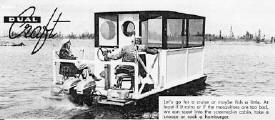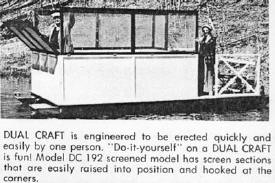by Andreas Jordahl Rhude
Everyone wanted to get in on the act of boat building during the boom years of the 1950s. Peacetime had finally arrived after WW II and the Korean War, the economy was on an upswing, and leisure time was plentiful. Everything was coming up roses. Water activities increased right along with other sports and fun-time events. Consumers demanded boats, so new manufacturers entered the market and established builders increased capacity.
 Super Structures, Inc. of Albert Lea, Minnesota came on board with their “All Purpose Dual Craft” pontoon boat in the mid-fifties. The boat was a sideline for them. Their main product was the manufacture of structural glued laminated timbers for use in framing buildings Most of their engineered timber beams, arches, trusses, and rafters went into agriculture markets. Rafters for barns and other farm buildings were their mainstay.
Super Structures, Inc. of Albert Lea, Minnesota came on board with their “All Purpose Dual Craft” pontoon boat in the mid-fifties. The boat was a sideline for them. Their main product was the manufacture of structural glued laminated timbers for use in framing buildings Most of their engineered timber beams, arches, trusses, and rafters went into agriculture markets. Rafters for barns and other farm buildings were their mainstay.
Formed in 1943 at Albert Lea by Myron K. Pedersen, Super Structures, Inc. was a spin-off of Rilco Laminated Products, Inc., a Weyerhaeuser family enterprise, of the same city. Pedersen had been the Rilco general manager but he wanted to be his own boss, so he departed, took some of Rilco’s leading employees and established Super Structures.
The company made large, glued laminated timbers and expanded to other lines during slack periods. For a number of years they made prefabricated hog and brooder houses. They also made wooden wagon boxes for farm use. In the mid 1950s boats joined their fleet of wares!
They must not have made many of the versatile craft nor stuck with them for very long. But what a boat with its use for fishing and camping and touring!
By the early 1960s Super Structures experience a large downturn in business, as markets for gothic shaped barn rafters was drying up. By 1964 they were pretty much shut down. The final death knell was sounded on 06 July 1965 when their manufacturing facility at Albert Lea was completely destroyed by fire. Investigations uncovered that three young boys set the plant ablaze. The firm ceased to exist with one fell swoop.
Although they made a few boats for a short period, their principal legacy lives on in the supporting roof beams and arches in many Midwestern farm buildings, not in their boats.

